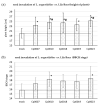Colletotrichum spp. from Soybean Cause Disease on Lupin and Can Induce Plant Growth-Promoting Effects
- PMID: 34073656
- PMCID: PMC8224748
- DOI: 10.3390/microorganisms9061130
Colletotrichum spp. from Soybean Cause Disease on Lupin and Can Induce Plant Growth-Promoting Effects
Abstract
Protein crop plants such as soybean and lupin are attracting increasing attention because of their potential use as forage, green manure, or for the production of oil and protein for human consumption. Whereas soybean production only recently gained more importance in Germany and within the whole EU in frame of protein strategies, lupin production is already well-established in Germany. The cultivation of lupins is impeded by the hemibiotrophic ascomycete Colletotrichum lupini, the causal agent of anthracnose disease. Worldwide, soybean is also a host for a variety of Colletotrichum species, but so far, this seems to not be the case in Germany. Cross-virulence between lupin- and soybean-infecting isolates is a potential threat, especially considering the overlap of possible soybean and lupin growing areas in Germany. To address this question, we systematically investigated the interaction of different Colletotrichum species isolated from soybean in Brazil on German soybean and lupin plant cultivars. Conversely, we tested the interaction of a German field isolate of C. lupini with soybean. Under controlled conditions, Colletotrichum species from soybean and lupin were able to cross-infect the other host plant with varying degrees of virulence, thus underpinning the potential risk of increased anthracnose diseases in the future. Interestingly, we observed a pronounced plant growth-promoting effect for some host-pathogen combinations, which might open the route to the use of beneficial biological agents in lupin and soybean production.
Keywords: Colletotrichum; anthracnose; commensalism; lupin; mutualism; parasitism; plant growth-promoting effect; protein crop plant; soybean.
Conflict of interest statement
The authors declare no conflict of interest.
Figures





Similar articles
-
Available Strategies for the Management of Andean Lupin Anthracnose.Plants (Basel). 2022 Feb 28;11(5):654. doi: 10.3390/plants11050654. Plants (Basel). 2022. PMID: 35270124 Free PMC article. Review.
-
Phylogenetic Diversity and Effect of Temperature on Pathogenicity of Colletotrichum lupini.Plant Dis. 2020 Mar;104(3):938-950. doi: 10.1094/PDIS-02-19-0273-RE. Epub 2020 Jan 13. Plant Dis. 2020. PMID: 31935344
-
Attack of the clones: Population genetics reveals clonality of Colletotrichum lupini, the causal agent of lupin anthracnose.Mol Plant Pathol. 2023 Jun;24(6):616-627. doi: 10.1111/mpp.13332. Epub 2023 Apr 20. Mol Plant Pathol. 2023. PMID: 37078402 Free PMC article.
-
Genetic and Morphological Characterization of Colletotrichum acutatum Causing Anthracnose of Lupins.Phytopathology. 2002 Sep;92(9):986-96. doi: 10.1094/PHYTO.2002.92.9.986. Phytopathology. 2002. PMID: 18944024
-
Advances in understanding the mechanism of resistance to anthracnose and induced defence response in tea plants.Mol Plant Pathol. 2023 Oct;24(10):1330-1346. doi: 10.1111/mpp.13354. Epub 2023 Jul 31. Mol Plant Pathol. 2023. PMID: 37522519 Free PMC article. Review.
Cited by
-
Available Strategies for the Management of Andean Lupin Anthracnose.Plants (Basel). 2022 Feb 28;11(5):654. doi: 10.3390/plants11050654. Plants (Basel). 2022. PMID: 35270124 Free PMC article. Review.
-
Endophytic fungus Colletotrichum sp. AP12 promotes growth physiology and andrographolide biosynthesis in Andrographis paniculata (Burm. f.) Nees.Front Plant Sci. 2023 Jul 4;14:1166803. doi: 10.3389/fpls.2023.1166803. eCollection 2023. Front Plant Sci. 2023. PMID: 37469772 Free PMC article.
References
-
- Talhinhas P., Baroncelli R., Le Floch G. Anthracnose of lupins caused by Colletotrichum lupini: A recent disease and a successful worldwide pathogen. J. Plant Pathol. 2016;98:5–14. doi: 10.4454/JPP.V98I1.040. - DOI
-
- Tian Q., Lu C., Wang S., Xiong Q., Zhang H., Wang Y., Zheng X. Rapid diagnosis of soybean anthracnose caused by Colletotrichum truncatum using a loop-mediated isothermal amplification (LAMP) assay. Eur. J. Plant Pathol. 2017;148:785–793. doi: 10.1007/s10658-016-1132-2. - DOI
-
- Ploper L.D., Backman P.A. Pest Management in Soybean. Springer; Dordrecht, The Netherlands: 1992. Nature and Management of Fungal Diseases Affecting Soybean Stems, Pods, and Seeds; pp. 174–184.
-
- Murphy-Bokern D., Stoddard F.L., Watson C.A. Legumes in cropping systems. Legum. Crop. Syst. 2017:1–256.
LinkOut - more resources
Full Text Sources
Miscellaneous

